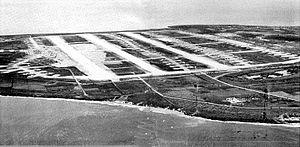North Field (Tinian)
North Field Ushi Point Airfield |
|
|---|---|
| Part of Twentieth Air Force | |
 Oblique airphoto of North Field, Tinian, 1945. Note the massive runway system and number of hardstands. Each hardstand where a B-29 was parked and maintained. |
|
| Coordinates | 15°04′19.36″N 145°38′18.13″E / 15.0720444°N 145.6383694°ECoordinates: 15°04′19.36″N 145°38′18.13″E / 15.0720444°N 145.6383694°E |
| Type | Military airfield |
| Site information | |
| Controlled by | United States Army Air Forces |
| Site history | |
| Built | 1944 |
| In use | 1944-1946 |
North Field is a former World War II airfield on Tinian in the Mariana Islands. Abandoned after the war, today North Field is a tourist attraction. Along with several adjacent beaches on which Allied forces landed during the Battle of Tinian, the airfield is the major component of the National Historic Landmark District Tinian Landing Beaches, Ushi Point Field, Tinian Island.
North Field was one of several bases for Twentieth Air Force Boeing B-29 Superfortress operations against the Japanese Home Islands in 1944–45. North Field contributed aircraft to the 1945 campaign to burn out Japanese cities with incendiary bombs, including the 9 March 1945 bombing of Tokyo which still stands as the most destructive air raid ever. North Field was the base for the 313th Bombardment Wing which carried out Operation Starvation, the dropping of naval mines in the harbors and sea lanes used by Japan. North Field was also the base for the 509th Composite Group which flew the atomic bombing raids on Hiroshima and Nagasaki in August 1945. The incendiary campaign (which destroyed 40% of the targeted cities), the aerial mining campaign (which starved Japan of essential food imports) and the two atomic attacks have all been argued as major factors in the surrender of Japan.
Tinian, with its sister islands of the Marianas, had passed through Spanish and German hands prior to becoming a Protectorate of Japan following World War I. Under Japanese administration, Tinian was largely a sugar plantation. In 1939, large-scale military construction began on Tinian by the Japanese Military. 1,200 prisoners were sent to the island from Japan for the construction of airfields as part of the defense of the Mariana Islands. By 1944, the island had three military airfields with a fourth under construction. What would become North Field was a Japanese airstrip 4,380' in length, known as Ushi Point Airfield and was home to the Nakajima C6N-1 reconnaissance aircraft of the 121st Kokutai Imperial Japanese Navy Air Service (IJNAS). Until the spring of 1944, the base remained largely out of major action.
...
Wikipedia
